Introduction to Business Management
VerifiedAdded on 2023/01/10
|14
|3982
|78
AI Summary
Business Management
Contribute Materials
Your contribution can guide someone’s learning journey. Share your
documents today.
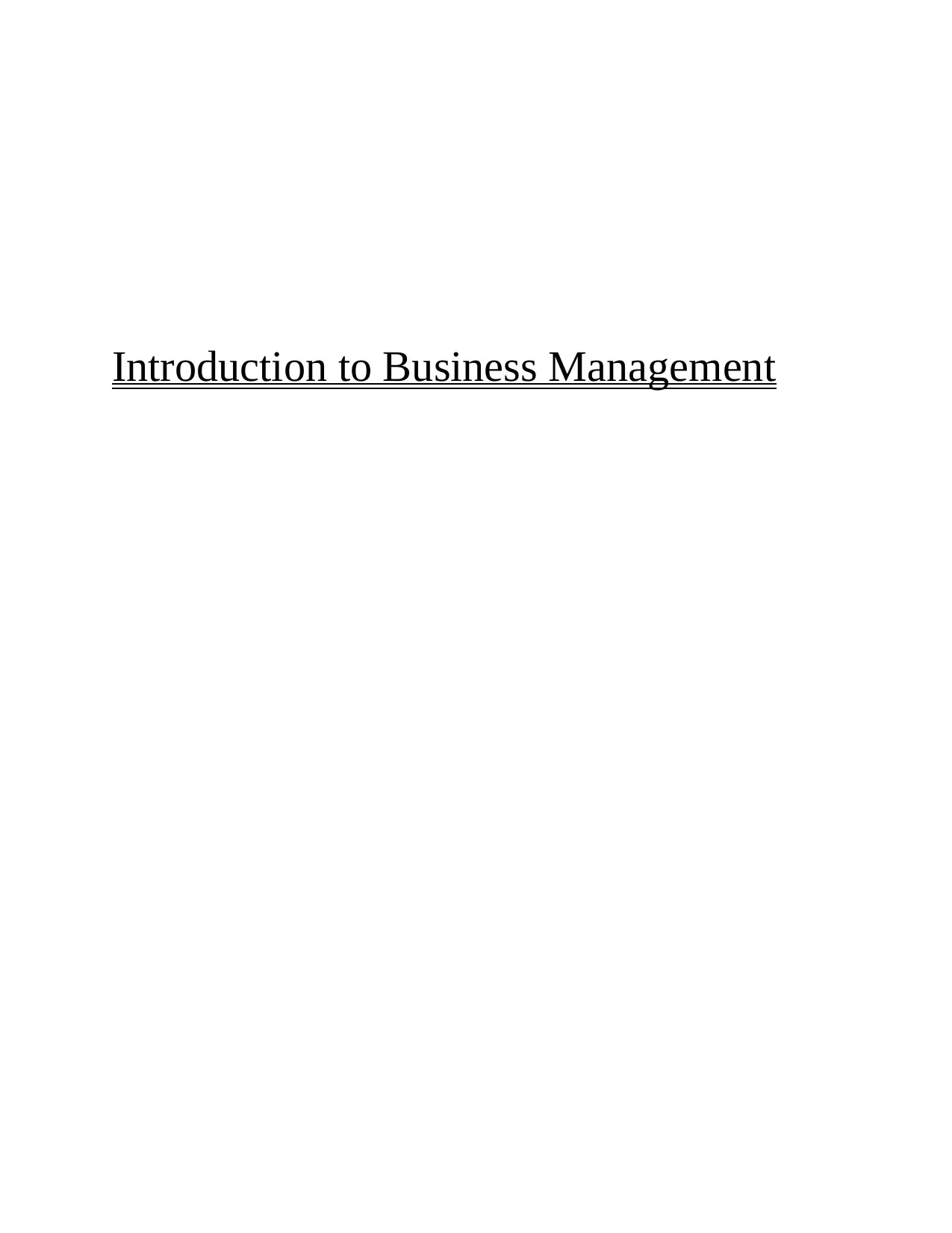
Introduction to Business Management
Secure Best Marks with AI Grader
Need help grading? Try our AI Grader for instant feedback on your assignments.
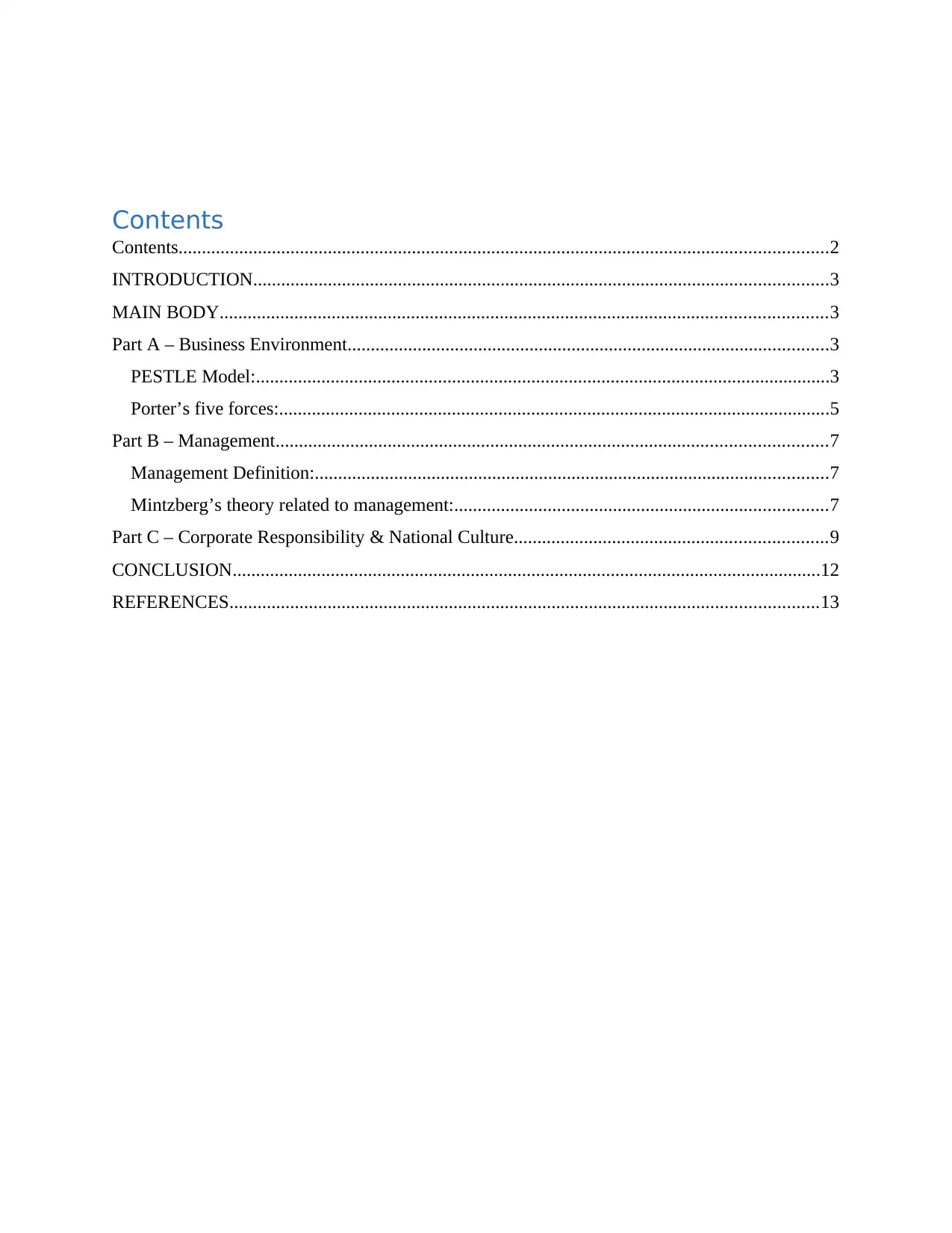
Contents
Contents...........................................................................................................................................2
INTRODUCTION...........................................................................................................................3
MAIN BODY..................................................................................................................................3
Part A – Business Environment.......................................................................................................3
PESTLE Model:...........................................................................................................................3
Porter’s five forces:......................................................................................................................5
Part B – Management......................................................................................................................7
Management Definition:..............................................................................................................7
Mintzberg’s theory related to management:................................................................................7
Part C – Corporate Responsibility & National Culture...................................................................9
CONCLUSION..............................................................................................................................12
REFERENCES..............................................................................................................................13
Contents...........................................................................................................................................2
INTRODUCTION...........................................................................................................................3
MAIN BODY..................................................................................................................................3
Part A – Business Environment.......................................................................................................3
PESTLE Model:...........................................................................................................................3
Porter’s five forces:......................................................................................................................5
Part B – Management......................................................................................................................7
Management Definition:..............................................................................................................7
Mintzberg’s theory related to management:................................................................................7
Part C – Corporate Responsibility & National Culture...................................................................9
CONCLUSION..............................................................................................................................12
REFERENCES..............................................................................................................................13
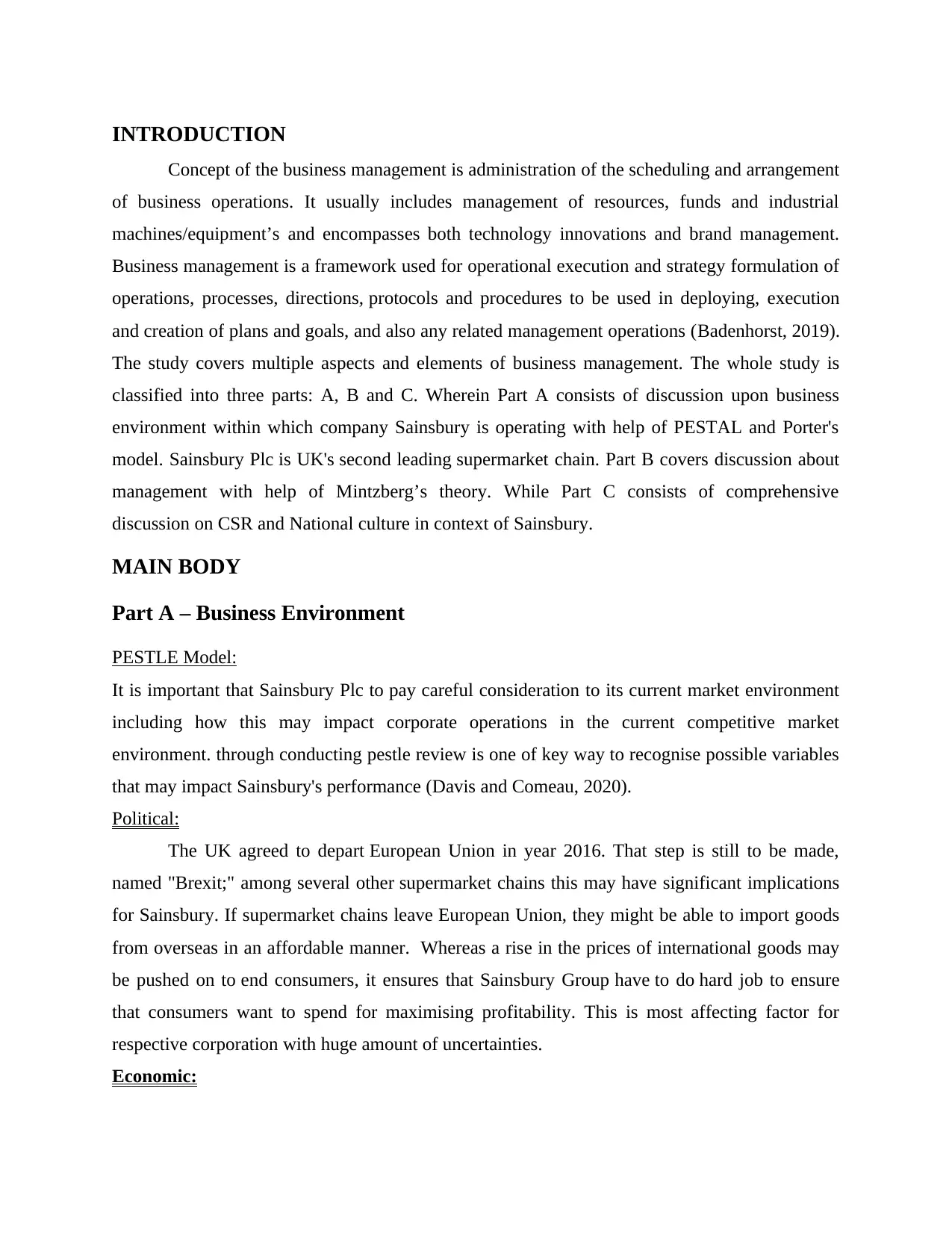
INTRODUCTION
Concept of the business management is administration of the scheduling and arrangement
of business operations. It usually includes management of resources, funds and industrial
machines/equipment’s and encompasses both technology innovations and brand management.
Business management is a framework used for operational execution and strategy formulation of
operations, processes, directions, protocols and procedures to be used in deploying, execution
and creation of plans and goals, and also any related management operations (Badenhorst, 2019).
The study covers multiple aspects and elements of business management. The whole study is
classified into three parts: A, B and C. Wherein Part A consists of discussion upon business
environment within which company Sainsbury is operating with help of PESTAL and Porter's
model. Sainsbury Plc is UK's second leading supermarket chain. Part B covers discussion about
management with help of Mintzberg’s theory. While Part C consists of comprehensive
discussion on CSR and National culture in context of Sainsbury.
MAIN BODY
Part A – Business Environment
PESTLE Model:
It is important that Sainsbury Plc to pay careful consideration to its current market environment
including how this may impact corporate operations in the current competitive market
environment. through conducting pestle review is one of key way to recognise possible variables
that may impact Sainsbury's performance (Davis and Comeau, 2020).
Political:
The UK agreed to depart European Union in year 2016. That step is still to be made,
named "Brexit;" among several other supermarket chains this may have significant implications
for Sainsbury. If supermarket chains leave European Union, they might be able to import goods
from overseas in an affordable manner. Whereas a rise in the prices of international goods may
be pushed on to end consumers, it ensures that Sainsbury Group have to do hard job to ensure
that consumers want to spend for maximising profitability. This is most affecting factor for
respective corporation with huge amount of uncertainties.
Economic:
Concept of the business management is administration of the scheduling and arrangement
of business operations. It usually includes management of resources, funds and industrial
machines/equipment’s and encompasses both technology innovations and brand management.
Business management is a framework used for operational execution and strategy formulation of
operations, processes, directions, protocols and procedures to be used in deploying, execution
and creation of plans and goals, and also any related management operations (Badenhorst, 2019).
The study covers multiple aspects and elements of business management. The whole study is
classified into three parts: A, B and C. Wherein Part A consists of discussion upon business
environment within which company Sainsbury is operating with help of PESTAL and Porter's
model. Sainsbury Plc is UK's second leading supermarket chain. Part B covers discussion about
management with help of Mintzberg’s theory. While Part C consists of comprehensive
discussion on CSR and National culture in context of Sainsbury.
MAIN BODY
Part A – Business Environment
PESTLE Model:
It is important that Sainsbury Plc to pay careful consideration to its current market environment
including how this may impact corporate operations in the current competitive market
environment. through conducting pestle review is one of key way to recognise possible variables
that may impact Sainsbury's performance (Davis and Comeau, 2020).
Political:
The UK agreed to depart European Union in year 2016. That step is still to be made,
named "Brexit;" among several other supermarket chains this may have significant implications
for Sainsbury. If supermarket chains leave European Union, they might be able to import goods
from overseas in an affordable manner. Whereas a rise in the prices of international goods may
be pushed on to end consumers, it ensures that Sainsbury Group have to do hard job to ensure
that consumers want to spend for maximising profitability. This is most affecting factor for
respective corporation with huge amount of uncertainties.
Economic:
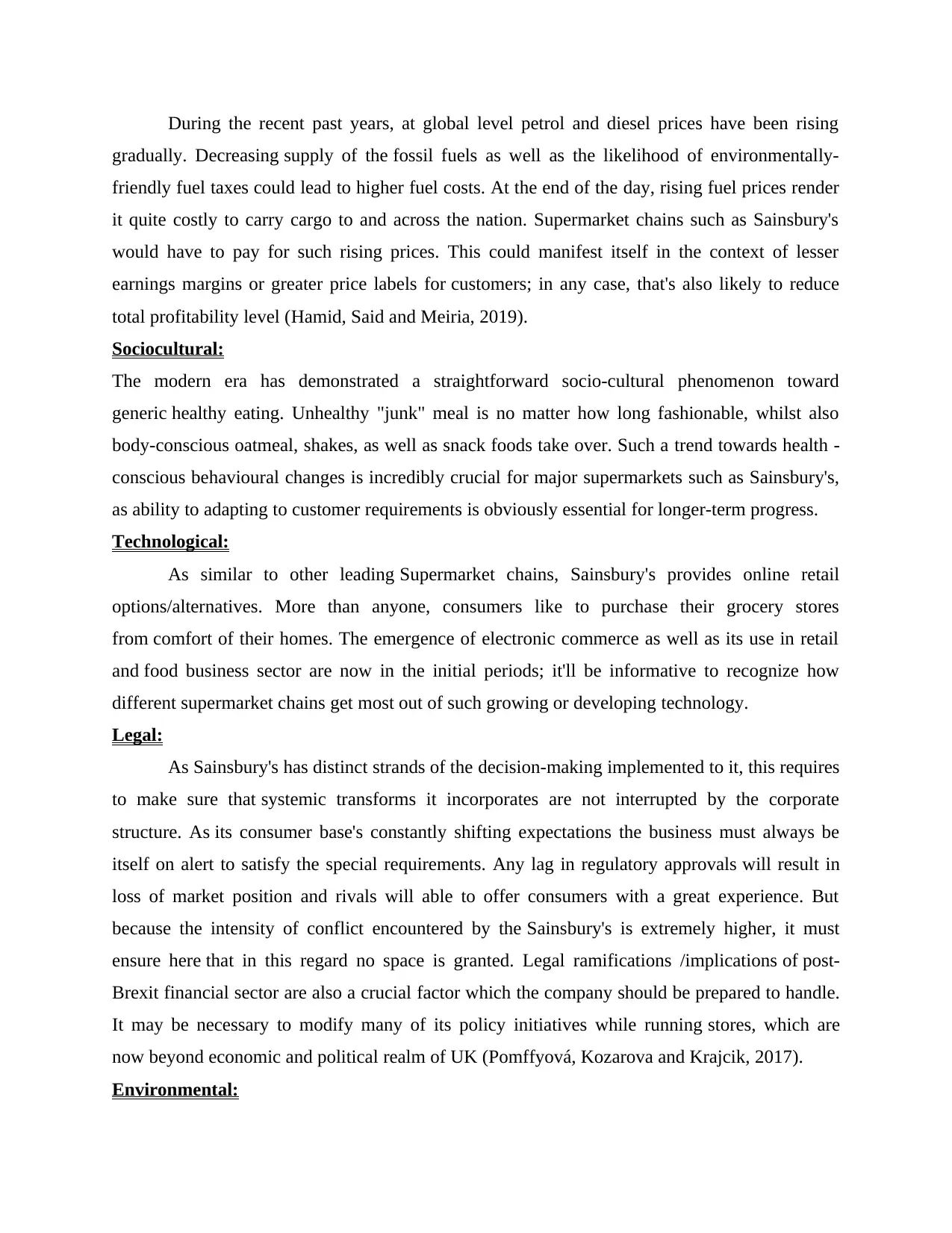
During the recent past years, at global level petrol and diesel prices have been rising
gradually. Decreasing supply of the fossil fuels as well as the likelihood of environmentally-
friendly fuel taxes could lead to higher fuel costs. At the end of the day, rising fuel prices render
it quite costly to carry cargo to and across the nation. Supermarket chains such as Sainsbury's
would have to pay for such rising prices. This could manifest itself in the context of lesser
earnings margins or greater price labels for customers; in any case, that's also likely to reduce
total profitability level (Hamid, Said and Meiria, 2019).
Sociocultural:
The modern era has demonstrated a straightforward socio-cultural phenomenon toward
generic healthy eating. Unhealthy "junk" meal is no matter how long fashionable, whilst also
body-conscious oatmeal, shakes, as well as snack foods take over. Such a trend towards health -
conscious behavioural changes is incredibly crucial for major supermarkets such as Sainsbury's,
as ability to adapting to customer requirements is obviously essential for longer-term progress.
Technological:
As similar to other leading Supermarket chains, Sainsbury's provides online retail
options/alternatives. More than anyone, consumers like to purchase their grocery stores
from comfort of their homes. The emergence of electronic commerce as well as its use in retail
and food business sector are now in the initial periods; it'll be informative to recognize how
different supermarket chains get most out of such growing or developing technology.
Legal:
As Sainsbury's has distinct strands of the decision-making implemented to it, this requires
to make sure that systemic transforms it incorporates are not interrupted by the corporate
structure. As its consumer base's constantly shifting expectations the business must always be
itself on alert to satisfy the special requirements. Any lag in regulatory approvals will result in
loss of market position and rivals will able to offer consumers with a great experience. But
because the intensity of conflict encountered by the Sainsbury's is extremely higher, it must
ensure here that in this regard no space is granted. Legal ramifications /implications of post-
Brexit financial sector are also a crucial factor which the company should be prepared to handle.
It may be necessary to modify many of its policy initiatives while running stores, which are
now beyond economic and political realm of UK (Pomffyová, Kozarova and Krajcik, 2017).
Environmental:
gradually. Decreasing supply of the fossil fuels as well as the likelihood of environmentally-
friendly fuel taxes could lead to higher fuel costs. At the end of the day, rising fuel prices render
it quite costly to carry cargo to and across the nation. Supermarket chains such as Sainsbury's
would have to pay for such rising prices. This could manifest itself in the context of lesser
earnings margins or greater price labels for customers; in any case, that's also likely to reduce
total profitability level (Hamid, Said and Meiria, 2019).
Sociocultural:
The modern era has demonstrated a straightforward socio-cultural phenomenon toward
generic healthy eating. Unhealthy "junk" meal is no matter how long fashionable, whilst also
body-conscious oatmeal, shakes, as well as snack foods take over. Such a trend towards health -
conscious behavioural changes is incredibly crucial for major supermarkets such as Sainsbury's,
as ability to adapting to customer requirements is obviously essential for longer-term progress.
Technological:
As similar to other leading Supermarket chains, Sainsbury's provides online retail
options/alternatives. More than anyone, consumers like to purchase their grocery stores
from comfort of their homes. The emergence of electronic commerce as well as its use in retail
and food business sector are now in the initial periods; it'll be informative to recognize how
different supermarket chains get most out of such growing or developing technology.
Legal:
As Sainsbury's has distinct strands of the decision-making implemented to it, this requires
to make sure that systemic transforms it incorporates are not interrupted by the corporate
structure. As its consumer base's constantly shifting expectations the business must always be
itself on alert to satisfy the special requirements. Any lag in regulatory approvals will result in
loss of market position and rivals will able to offer consumers with a great experience. But
because the intensity of conflict encountered by the Sainsbury's is extremely higher, it must
ensure here that in this regard no space is granted. Legal ramifications /implications of post-
Brexit financial sector are also a crucial factor which the company should be prepared to handle.
It may be necessary to modify many of its policy initiatives while running stores, which are
now beyond economic and political realm of UK (Pomffyová, Kozarova and Krajcik, 2017).
Environmental:
Secure Best Marks with AI Grader
Need help grading? Try our AI Grader for instant feedback on your assignments.
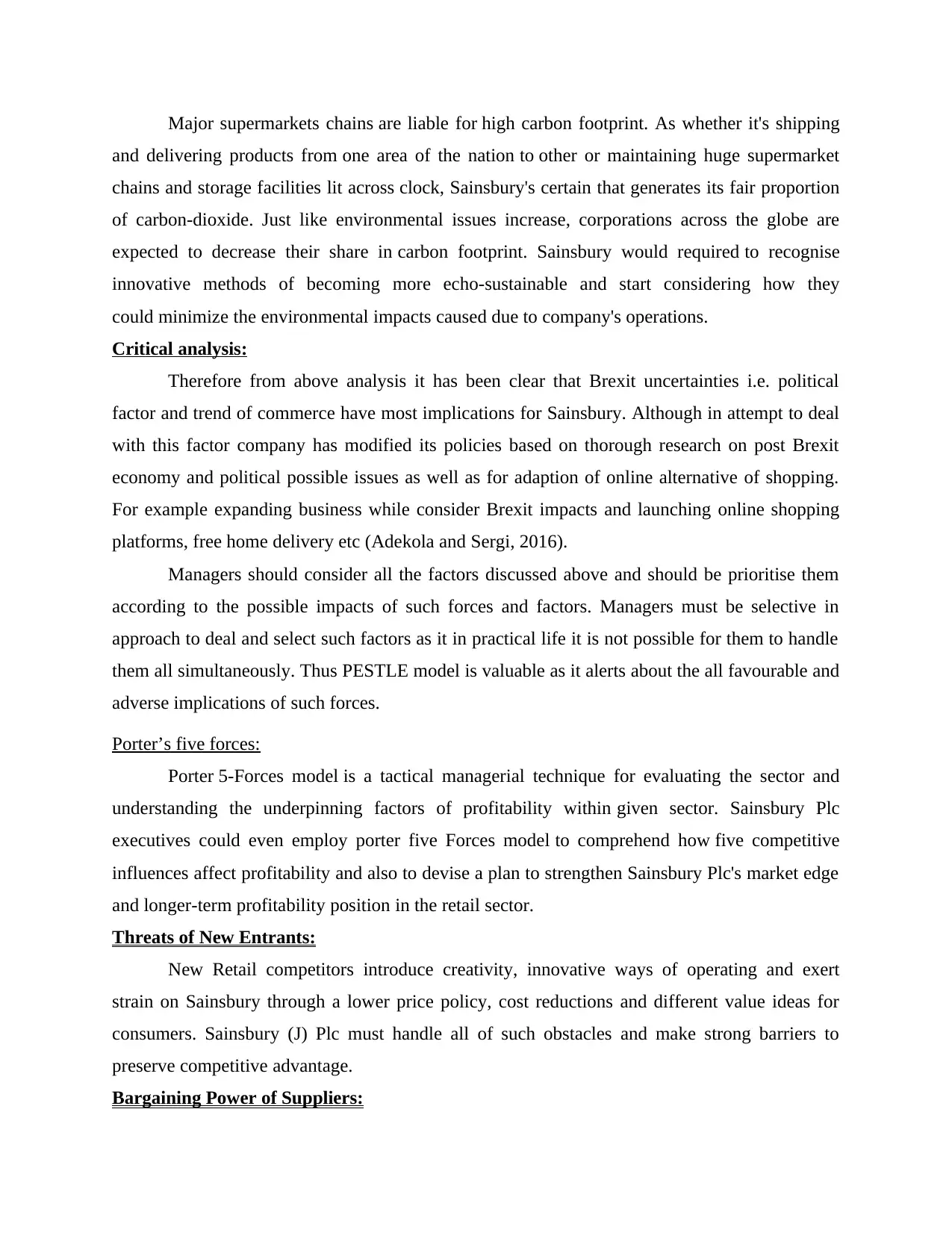
Major supermarkets chains are liable for high carbon footprint. As whether it's shipping
and delivering products from one area of the nation to other or maintaining huge supermarket
chains and storage facilities lit across clock, Sainsbury's certain that generates its fair proportion
of carbon-dioxide. Just like environmental issues increase, corporations across the globe are
expected to decrease their share in carbon footprint. Sainsbury would required to recognise
innovative methods of becoming more echo-sustainable and start considering how they
could minimize the environmental impacts caused due to company's operations.
Critical analysis:
Therefore from above analysis it has been clear that Brexit uncertainties i.e. political
factor and trend of commerce have most implications for Sainsbury. Although in attempt to deal
with this factor company has modified its policies based on thorough research on post Brexit
economy and political possible issues as well as for adaption of online alternative of shopping.
For example expanding business while consider Brexit impacts and launching online shopping
platforms, free home delivery etc (Adekola and Sergi, 2016).
Managers should consider all the factors discussed above and should be prioritise them
according to the possible impacts of such forces and factors. Managers must be selective in
approach to deal and select such factors as it in practical life it is not possible for them to handle
them all simultaneously. Thus PESTLE model is valuable as it alerts about the all favourable and
adverse implications of such forces.
Porter’s five forces:
Porter 5-Forces model is a tactical managerial technique for evaluating the sector and
understanding the underpinning factors of profitability within given sector. Sainsbury Plc
executives could even employ porter five Forces model to comprehend how five competitive
influences affect profitability and also to devise a plan to strengthen Sainsbury Plc's market edge
and longer-term profitability position in the retail sector.
Threats of New Entrants:
New Retail competitors introduce creativity, innovative ways of operating and exert
strain on Sainsbury through a lower price policy, cost reductions and different value ideas for
consumers. Sainsbury (J) Plc must handle all of such obstacles and make strong barriers to
preserve competitive advantage.
Bargaining Power of Suppliers:
and delivering products from one area of the nation to other or maintaining huge supermarket
chains and storage facilities lit across clock, Sainsbury's certain that generates its fair proportion
of carbon-dioxide. Just like environmental issues increase, corporations across the globe are
expected to decrease their share in carbon footprint. Sainsbury would required to recognise
innovative methods of becoming more echo-sustainable and start considering how they
could minimize the environmental impacts caused due to company's operations.
Critical analysis:
Therefore from above analysis it has been clear that Brexit uncertainties i.e. political
factor and trend of commerce have most implications for Sainsbury. Although in attempt to deal
with this factor company has modified its policies based on thorough research on post Brexit
economy and political possible issues as well as for adaption of online alternative of shopping.
For example expanding business while consider Brexit impacts and launching online shopping
platforms, free home delivery etc (Adekola and Sergi, 2016).
Managers should consider all the factors discussed above and should be prioritise them
according to the possible impacts of such forces and factors. Managers must be selective in
approach to deal and select such factors as it in practical life it is not possible for them to handle
them all simultaneously. Thus PESTLE model is valuable as it alerts about the all favourable and
adverse implications of such forces.
Porter’s five forces:
Porter 5-Forces model is a tactical managerial technique for evaluating the sector and
understanding the underpinning factors of profitability within given sector. Sainsbury Plc
executives could even employ porter five Forces model to comprehend how five competitive
influences affect profitability and also to devise a plan to strengthen Sainsbury Plc's market edge
and longer-term profitability position in the retail sector.
Threats of New Entrants:
New Retail competitors introduce creativity, innovative ways of operating and exert
strain on Sainsbury through a lower price policy, cost reductions and different value ideas for
consumers. Sainsbury (J) Plc must handle all of such obstacles and make strong barriers to
preserve competitive advantage.
Bargaining Power of Suppliers:
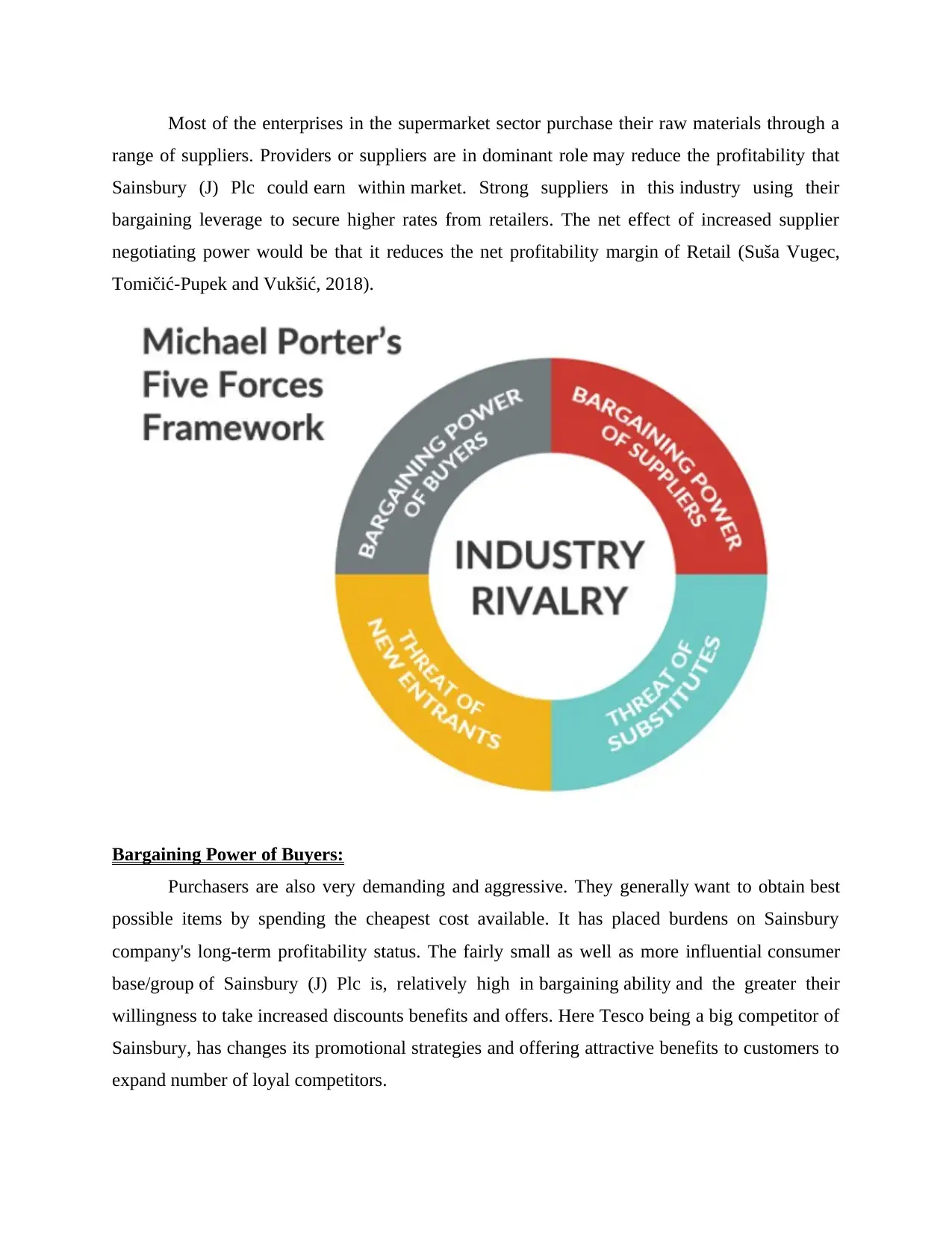
Most of the enterprises in the supermarket sector purchase their raw materials through a
range of suppliers. Providers or suppliers are in dominant role may reduce the profitability that
Sainsbury (J) Plc could earn within market. Strong suppliers in this industry using their
bargaining leverage to secure higher rates from retailers. The net effect of increased supplier
negotiating power would be that it reduces the net profitability margin of Retail (Suša Vugec,
Tomičić-Pupek and Vukšić, 2018).
Bargaining Power of Buyers:
Purchasers are also very demanding and aggressive. They generally want to obtain best
possible items by spending the cheapest cost available. It has placed burdens on Sainsbury
company's long-term profitability status. The fairly small as well as more influential consumer
base/group of Sainsbury (J) Plc is, relatively high in bargaining ability and the greater their
willingness to take increased discounts benefits and offers. Here Tesco being a big competitor of
Sainsbury, has changes its promotional strategies and offering attractive benefits to customers to
expand number of loyal competitors.
range of suppliers. Providers or suppliers are in dominant role may reduce the profitability that
Sainsbury (J) Plc could earn within market. Strong suppliers in this industry using their
bargaining leverage to secure higher rates from retailers. The net effect of increased supplier
negotiating power would be that it reduces the net profitability margin of Retail (Suša Vugec,
Tomičić-Pupek and Vukšić, 2018).
Bargaining Power of Buyers:
Purchasers are also very demanding and aggressive. They generally want to obtain best
possible items by spending the cheapest cost available. It has placed burdens on Sainsbury
company's long-term profitability status. The fairly small as well as more influential consumer
base/group of Sainsbury (J) Plc is, relatively high in bargaining ability and the greater their
willingness to take increased discounts benefits and offers. Here Tesco being a big competitor of
Sainsbury, has changes its promotional strategies and offering attractive benefits to customers to
expand number of loyal competitors.
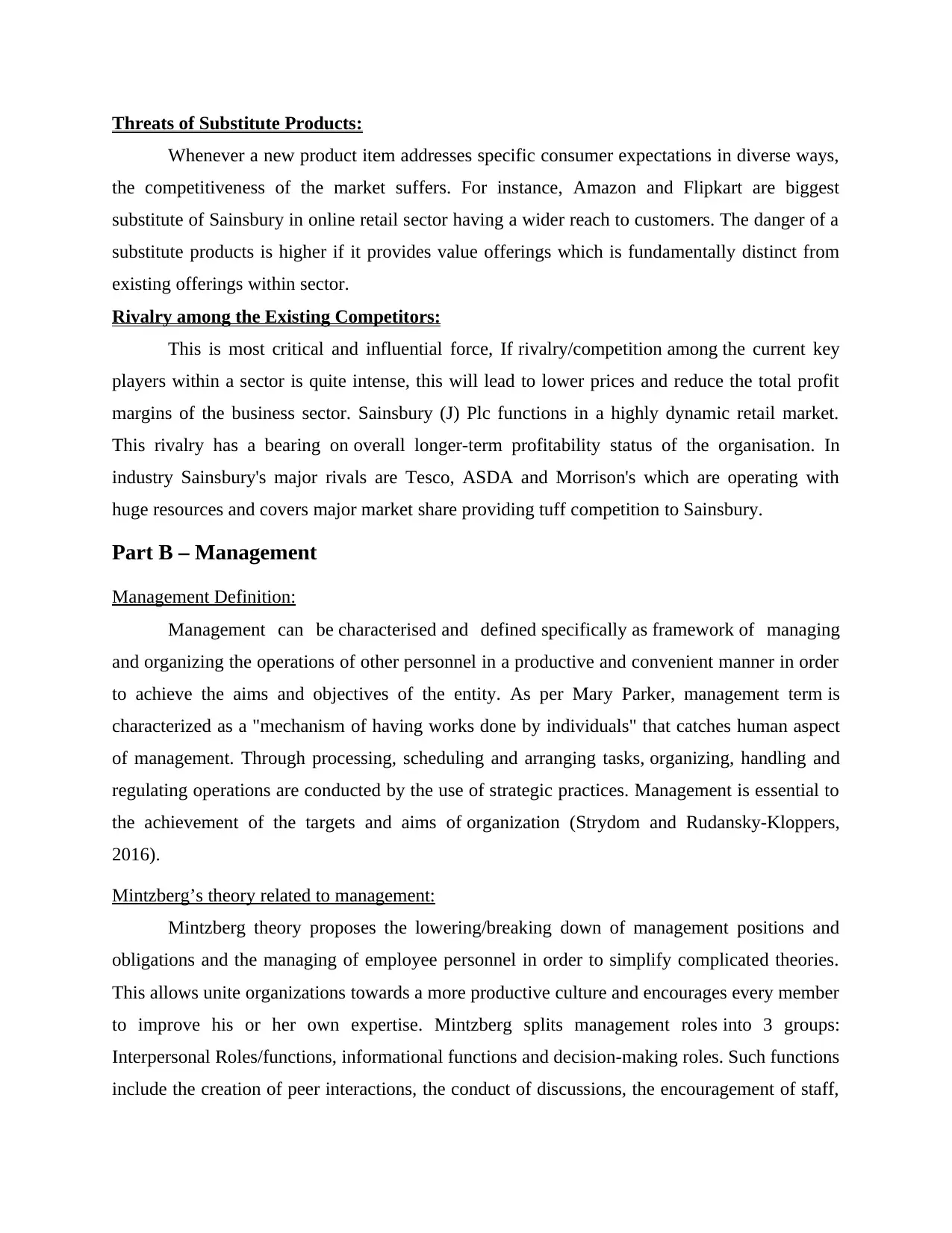
Threats of Substitute Products:
Whenever a new product item addresses specific consumer expectations in diverse ways,
the competitiveness of the market suffers. For instance, Amazon and Flipkart are biggest
substitute of Sainsbury in online retail sector having a wider reach to customers. The danger of a
substitute products is higher if it provides value offerings which is fundamentally distinct from
existing offerings within sector.
Rivalry among the Existing Competitors:
This is most critical and influential force, If rivalry/competition among the current key
players within a sector is quite intense, this will lead to lower prices and reduce the total profit
margins of the business sector. Sainsbury (J) Plc functions in a highly dynamic retail market.
This rivalry has a bearing on overall longer-term profitability status of the organisation. In
industry Sainsbury's major rivals are Tesco, ASDA and Morrison's which are operating with
huge resources and covers major market share providing tuff competition to Sainsbury.
Part B – Management
Management Definition:
Management can be characterised and defined specifically as framework of managing
and organizing the operations of other personnel in a productive and convenient manner in order
to achieve the aims and objectives of the entity. As per Mary Parker, management term is
characterized as a "mechanism of having works done by individuals" that catches human aspect
of management. Through processing, scheduling and arranging tasks, organizing, handling and
regulating operations are conducted by the use of strategic practices. Management is essential to
the achievement of the targets and aims of organization (Strydom and Rudansky-Kloppers,
2016).
Mintzberg’s theory related to management:
Mintzberg theory proposes the lowering/breaking down of management positions and
obligations and the managing of employee personnel in order to simplify complicated theories.
This allows unite organizations towards a more productive culture and encourages every member
to improve his or her own expertise. Mintzberg splits management roles into 3 groups:
Interpersonal Roles/functions, informational functions and decision-making roles. Such functions
include the creation of peer interactions, the conduct of discussions, the encouragement of staff,
Whenever a new product item addresses specific consumer expectations in diverse ways,
the competitiveness of the market suffers. For instance, Amazon and Flipkart are biggest
substitute of Sainsbury in online retail sector having a wider reach to customers. The danger of a
substitute products is higher if it provides value offerings which is fundamentally distinct from
existing offerings within sector.
Rivalry among the Existing Competitors:
This is most critical and influential force, If rivalry/competition among the current key
players within a sector is quite intense, this will lead to lower prices and reduce the total profit
margins of the business sector. Sainsbury (J) Plc functions in a highly dynamic retail market.
This rivalry has a bearing on overall longer-term profitability status of the organisation. In
industry Sainsbury's major rivals are Tesco, ASDA and Morrison's which are operating with
huge resources and covers major market share providing tuff competition to Sainsbury.
Part B – Management
Management Definition:
Management can be characterised and defined specifically as framework of managing
and organizing the operations of other personnel in a productive and convenient manner in order
to achieve the aims and objectives of the entity. As per Mary Parker, management term is
characterized as a "mechanism of having works done by individuals" that catches human aspect
of management. Through processing, scheduling and arranging tasks, organizing, handling and
regulating operations are conducted by the use of strategic practices. Management is essential to
the achievement of the targets and aims of organization (Strydom and Rudansky-Kloppers,
2016).
Mintzberg’s theory related to management:
Mintzberg theory proposes the lowering/breaking down of management positions and
obligations and the managing of employee personnel in order to simplify complicated theories.
This allows unite organizations towards a more productive culture and encourages every member
to improve his or her own expertise. Mintzberg splits management roles into 3 groups:
Interpersonal Roles/functions, informational functions and decision-making roles. Such functions
include the creation of peer interactions, the conduct of discussions, the encouragement of staff,
Paraphrase This Document
Need a fresh take? Get an instant paraphrase of this document with our AI Paraphraser
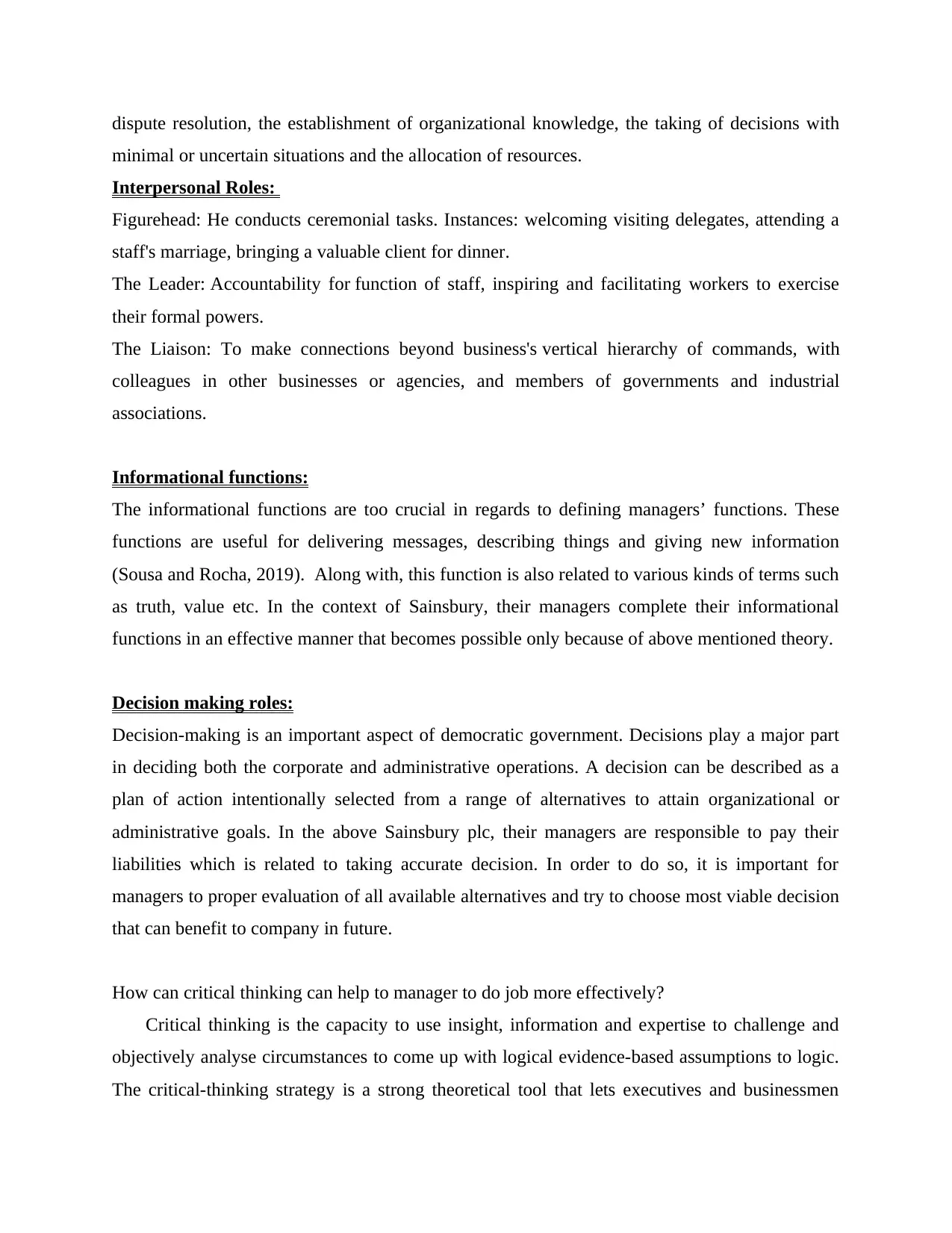
dispute resolution, the establishment of organizational knowledge, the taking of decisions with
minimal or uncertain situations and the allocation of resources.
Interpersonal Roles:
Figurehead: He conducts ceremonial tasks. Instances: welcoming visiting delegates, attending a
staff's marriage, bringing a valuable client for dinner.
The Leader: Accountability for function of staff, inspiring and facilitating workers to exercise
their formal powers.
The Liaison: To make connections beyond business's vertical hierarchy of commands, with
colleagues in other businesses or agencies, and members of governments and industrial
associations.
Informational functions:
The informational functions are too crucial in regards to defining managers’ functions. These
functions are useful for delivering messages, describing things and giving new information
(Sousa and Rocha, 2019). Along with, this function is also related to various kinds of terms such
as truth, value etc. In the context of Sainsbury, their managers complete their informational
functions in an effective manner that becomes possible only because of above mentioned theory.
Decision making roles:
Decision-making is an important aspect of democratic government. Decisions play a major part
in deciding both the corporate and administrative operations. A decision can be described as a
plan of action intentionally selected from a range of alternatives to attain organizational or
administrative goals. In the above Sainsbury plc, their managers are responsible to pay their
liabilities which is related to taking accurate decision. In order to do so, it is important for
managers to proper evaluation of all available alternatives and try to choose most viable decision
that can benefit to company in future.
How can critical thinking can help to manager to do job more effectively?
Critical thinking is the capacity to use insight, information and expertise to challenge and
objectively analyse circumstances to come up with logical evidence-based assumptions to logic.
The critical-thinking strategy is a strong theoretical tool that lets executives and businessmen
minimal or uncertain situations and the allocation of resources.
Interpersonal Roles:
Figurehead: He conducts ceremonial tasks. Instances: welcoming visiting delegates, attending a
staff's marriage, bringing a valuable client for dinner.
The Leader: Accountability for function of staff, inspiring and facilitating workers to exercise
their formal powers.
The Liaison: To make connections beyond business's vertical hierarchy of commands, with
colleagues in other businesses or agencies, and members of governments and industrial
associations.
Informational functions:
The informational functions are too crucial in regards to defining managers’ functions. These
functions are useful for delivering messages, describing things and giving new information
(Sousa and Rocha, 2019). Along with, this function is also related to various kinds of terms such
as truth, value etc. In the context of Sainsbury, their managers complete their informational
functions in an effective manner that becomes possible only because of above mentioned theory.
Decision making roles:
Decision-making is an important aspect of democratic government. Decisions play a major part
in deciding both the corporate and administrative operations. A decision can be described as a
plan of action intentionally selected from a range of alternatives to attain organizational or
administrative goals. In the above Sainsbury plc, their managers are responsible to pay their
liabilities which is related to taking accurate decision. In order to do so, it is important for
managers to proper evaluation of all available alternatives and try to choose most viable decision
that can benefit to company in future.
How can critical thinking can help to manager to do job more effectively?
Critical thinking is the capacity to use insight, information and expertise to challenge and
objectively analyse circumstances to come up with logical evidence-based assumptions to logic.
The critical-thinking strategy is a strong theoretical tool that lets executives and businessmen
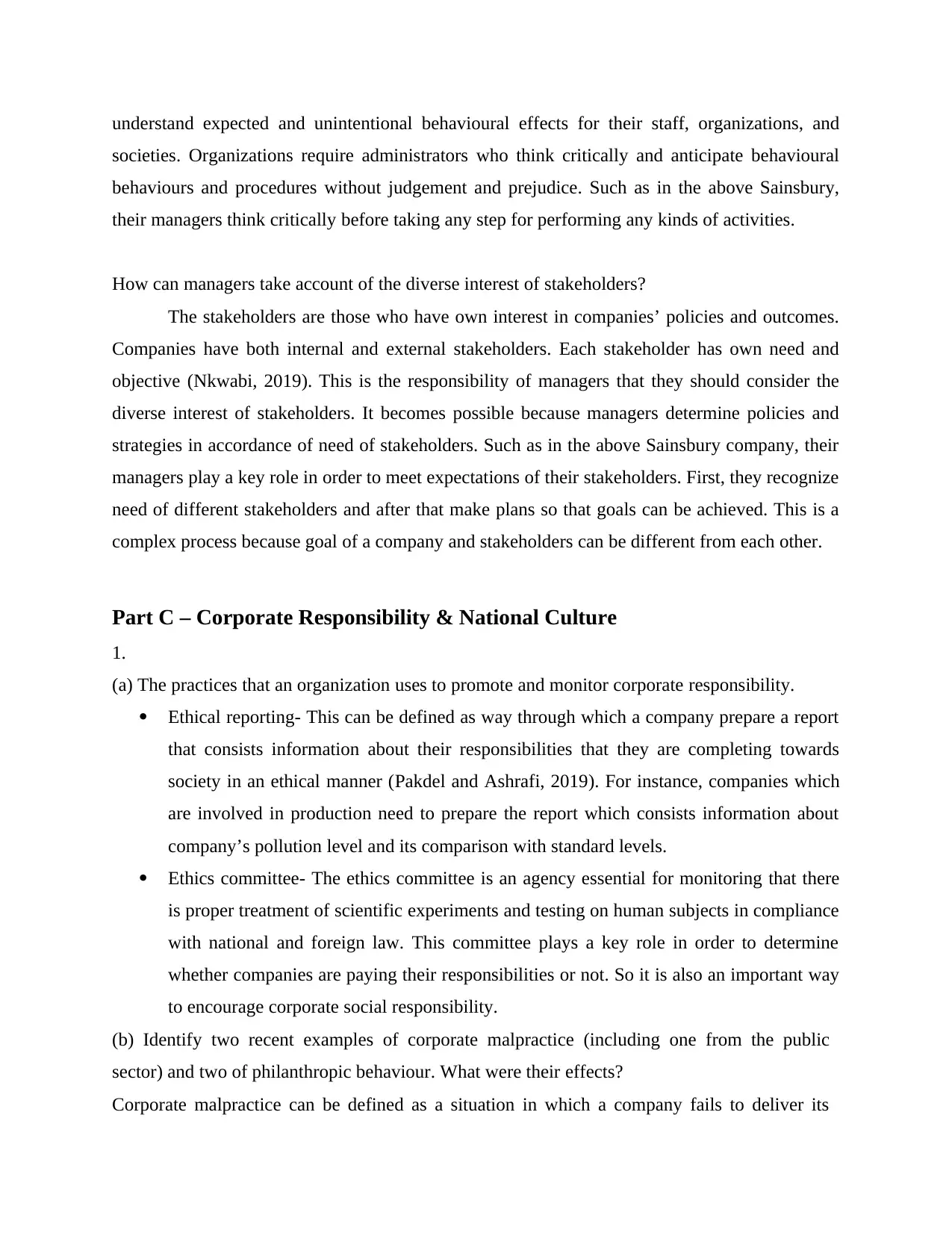
understand expected and unintentional behavioural effects for their staff, organizations, and
societies. Organizations require administrators who think critically and anticipate behavioural
behaviours and procedures without judgement and prejudice. Such as in the above Sainsbury,
their managers think critically before taking any step for performing any kinds of activities.
How can managers take account of the diverse interest of stakeholders?
The stakeholders are those who have own interest in companies’ policies and outcomes.
Companies have both internal and external stakeholders. Each stakeholder has own need and
objective (Nkwabi, 2019). This is the responsibility of managers that they should consider the
diverse interest of stakeholders. It becomes possible because managers determine policies and
strategies in accordance of need of stakeholders. Such as in the above Sainsbury company, their
managers play a key role in order to meet expectations of their stakeholders. First, they recognize
need of different stakeholders and after that make plans so that goals can be achieved. This is a
complex process because goal of a company and stakeholders can be different from each other.
Part C – Corporate Responsibility & National Culture
1.
(a) The practices that an organization uses to promote and monitor corporate responsibility.
Ethical reporting- This can be defined as way through which a company prepare a report
that consists information about their responsibilities that they are completing towards
society in an ethical manner (Pakdel and Ashrafi, 2019). For instance, companies which
are involved in production need to prepare the report which consists information about
company’s pollution level and its comparison with standard levels.
Ethics committee- The ethics committee is an agency essential for monitoring that there
is proper treatment of scientific experiments and testing on human subjects in compliance
with national and foreign law. This committee plays a key role in order to determine
whether companies are paying their responsibilities or not. So it is also an important way
to encourage corporate social responsibility.
(b) Identify two recent examples of corporate malpractice (including one from the public
sector) and two of philanthropic behaviour. What were their effects?
Corporate malpractice can be defined as a situation in which a company fails to deliver its
societies. Organizations require administrators who think critically and anticipate behavioural
behaviours and procedures without judgement and prejudice. Such as in the above Sainsbury,
their managers think critically before taking any step for performing any kinds of activities.
How can managers take account of the diverse interest of stakeholders?
The stakeholders are those who have own interest in companies’ policies and outcomes.
Companies have both internal and external stakeholders. Each stakeholder has own need and
objective (Nkwabi, 2019). This is the responsibility of managers that they should consider the
diverse interest of stakeholders. It becomes possible because managers determine policies and
strategies in accordance of need of stakeholders. Such as in the above Sainsbury company, their
managers play a key role in order to meet expectations of their stakeholders. First, they recognize
need of different stakeholders and after that make plans so that goals can be achieved. This is a
complex process because goal of a company and stakeholders can be different from each other.
Part C – Corporate Responsibility & National Culture
1.
(a) The practices that an organization uses to promote and monitor corporate responsibility.
Ethical reporting- This can be defined as way through which a company prepare a report
that consists information about their responsibilities that they are completing towards
society in an ethical manner (Pakdel and Ashrafi, 2019). For instance, companies which
are involved in production need to prepare the report which consists information about
company’s pollution level and its comparison with standard levels.
Ethics committee- The ethics committee is an agency essential for monitoring that there
is proper treatment of scientific experiments and testing on human subjects in compliance
with national and foreign law. This committee plays a key role in order to determine
whether companies are paying their responsibilities or not. So it is also an important way
to encourage corporate social responsibility.
(b) Identify two recent examples of corporate malpractice (including one from the public
sector) and two of philanthropic behaviour. What were their effects?
Corporate malpractice can be defined as a situation in which a company fails to deliver its
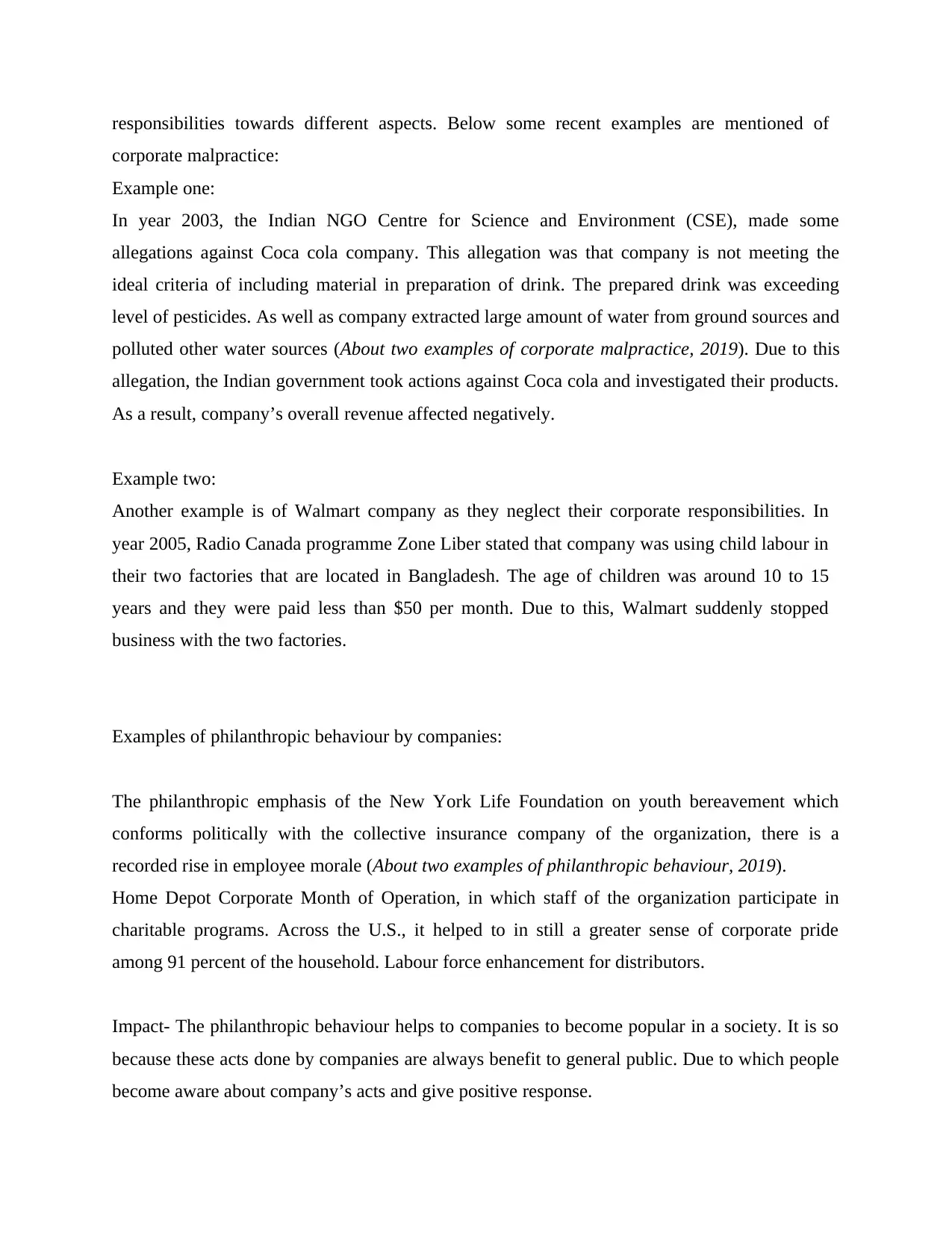
responsibilities towards different aspects. Below some recent examples are mentioned of
corporate malpractice:
Example one:
In year 2003, the Indian NGO Centre for Science and Environment (CSE), made some
allegations against Coca cola company. This allegation was that company is not meeting the
ideal criteria of including material in preparation of drink. The prepared drink was exceeding
level of pesticides. As well as company extracted large amount of water from ground sources and
polluted other water sources (About two examples of corporate malpractice, 2019). Due to this
allegation, the Indian government took actions against Coca cola and investigated their products.
As a result, company’s overall revenue affected negatively.
Example two:
Another example is of Walmart company as they neglect their corporate responsibilities. In
year 2005, Radio Canada programme Zone Liber stated that company was using child labour in
their two factories that are located in Bangladesh. The age of children was around 10 to 15
years and they were paid less than $50 per month. Due to this, Walmart suddenly stopped
business with the two factories.
Examples of philanthropic behaviour by companies:
The philanthropic emphasis of the New York Life Foundation on youth bereavement which
conforms politically with the collective insurance company of the organization, there is a
recorded rise in employee morale (About two examples of philanthropic behaviour, 2019).
Home Depot Corporate Month of Operation, in which staff of the organization participate in
charitable programs. Across the U.S., it helped to in still a greater sense of corporate pride
among 91 percent of the household. Labour force enhancement for distributors.
Impact- The philanthropic behaviour helps to companies to become popular in a society. It is so
because these acts done by companies are always benefit to general public. Due to which people
become aware about company’s acts and give positive response.
corporate malpractice:
Example one:
In year 2003, the Indian NGO Centre for Science and Environment (CSE), made some
allegations against Coca cola company. This allegation was that company is not meeting the
ideal criteria of including material in preparation of drink. The prepared drink was exceeding
level of pesticides. As well as company extracted large amount of water from ground sources and
polluted other water sources (About two examples of corporate malpractice, 2019). Due to this
allegation, the Indian government took actions against Coca cola and investigated their products.
As a result, company’s overall revenue affected negatively.
Example two:
Another example is of Walmart company as they neglect their corporate responsibilities. In
year 2005, Radio Canada programme Zone Liber stated that company was using child labour in
their two factories that are located in Bangladesh. The age of children was around 10 to 15
years and they were paid less than $50 per month. Due to this, Walmart suddenly stopped
business with the two factories.
Examples of philanthropic behaviour by companies:
The philanthropic emphasis of the New York Life Foundation on youth bereavement which
conforms politically with the collective insurance company of the organization, there is a
recorded rise in employee morale (About two examples of philanthropic behaviour, 2019).
Home Depot Corporate Month of Operation, in which staff of the organization participate in
charitable programs. Across the U.S., it helped to in still a greater sense of corporate pride
among 91 percent of the household. Labour force enhancement for distributors.
Impact- The philanthropic behaviour helps to companies to become popular in a society. It is so
because these acts done by companies are always benefit to general public. Due to which people
become aware about company’s acts and give positive response.
Secure Best Marks with AI Grader
Need help grading? Try our AI Grader for instant feedback on your assignments.
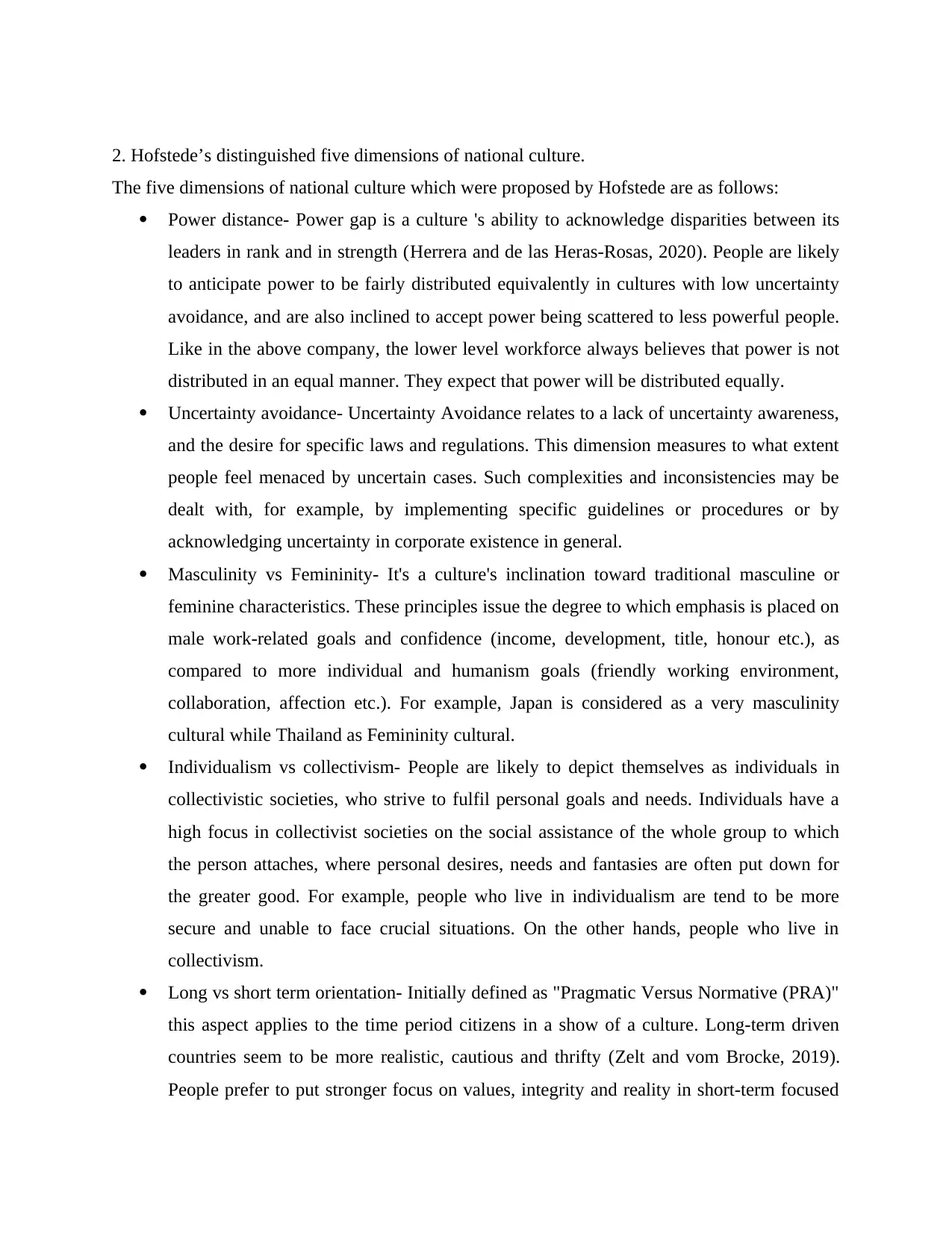
2. Hofstede’s distinguished five dimensions of national culture.
The five dimensions of national culture which were proposed by Hofstede are as follows:
Power distance- Power gap is a culture 's ability to acknowledge disparities between its
leaders in rank and in strength (Herrera and de las Heras-Rosas, 2020). People are likely
to anticipate power to be fairly distributed equivalently in cultures with low uncertainty
avoidance, and are also inclined to accept power being scattered to less powerful people.
Like in the above company, the lower level workforce always believes that power is not
distributed in an equal manner. They expect that power will be distributed equally.
Uncertainty avoidance- Uncertainty Avoidance relates to a lack of uncertainty awareness,
and the desire for specific laws and regulations. This dimension measures to what extent
people feel menaced by uncertain cases. Such complexities and inconsistencies may be
dealt with, for example, by implementing specific guidelines or procedures or by
acknowledging uncertainty in corporate existence in general.
Masculinity vs Femininity- It's a culture's inclination toward traditional masculine or
feminine characteristics. These principles issue the degree to which emphasis is placed on
male work-related goals and confidence (income, development, title, honour etc.), as
compared to more individual and humanism goals (friendly working environment,
collaboration, affection etc.). For example, Japan is considered as a very masculinity
cultural while Thailand as Femininity cultural.
Individualism vs collectivism- People are likely to depict themselves as individuals in
collectivistic societies, who strive to fulfil personal goals and needs. Individuals have a
high focus in collectivist societies on the social assistance of the whole group to which
the person attaches, where personal desires, needs and fantasies are often put down for
the greater good. For example, people who live in individualism are tend to be more
secure and unable to face crucial situations. On the other hands, people who live in
collectivism.
Long vs short term orientation- Initially defined as "Pragmatic Versus Normative (PRA)"
this aspect applies to the time period citizens in a show of a culture. Long-term driven
countries seem to be more realistic, cautious and thrifty (Zelt and vom Brocke, 2019).
People prefer to put stronger focus on values, integrity and reality in short-term focused
The five dimensions of national culture which were proposed by Hofstede are as follows:
Power distance- Power gap is a culture 's ability to acknowledge disparities between its
leaders in rank and in strength (Herrera and de las Heras-Rosas, 2020). People are likely
to anticipate power to be fairly distributed equivalently in cultures with low uncertainty
avoidance, and are also inclined to accept power being scattered to less powerful people.
Like in the above company, the lower level workforce always believes that power is not
distributed in an equal manner. They expect that power will be distributed equally.
Uncertainty avoidance- Uncertainty Avoidance relates to a lack of uncertainty awareness,
and the desire for specific laws and regulations. This dimension measures to what extent
people feel menaced by uncertain cases. Such complexities and inconsistencies may be
dealt with, for example, by implementing specific guidelines or procedures or by
acknowledging uncertainty in corporate existence in general.
Masculinity vs Femininity- It's a culture's inclination toward traditional masculine or
feminine characteristics. These principles issue the degree to which emphasis is placed on
male work-related goals and confidence (income, development, title, honour etc.), as
compared to more individual and humanism goals (friendly working environment,
collaboration, affection etc.). For example, Japan is considered as a very masculinity
cultural while Thailand as Femininity cultural.
Individualism vs collectivism- People are likely to depict themselves as individuals in
collectivistic societies, who strive to fulfil personal goals and needs. Individuals have a
high focus in collectivist societies on the social assistance of the whole group to which
the person attaches, where personal desires, needs and fantasies are often put down for
the greater good. For example, people who live in individualism are tend to be more
secure and unable to face crucial situations. On the other hands, people who live in
collectivism.
Long vs short term orientation- Initially defined as "Pragmatic Versus Normative (PRA)"
this aspect applies to the time period citizens in a show of a culture. Long-term driven
countries seem to be more realistic, cautious and thrifty (Zelt and vom Brocke, 2019).
People prefer to put stronger focus on values, integrity and reality in short-term focused
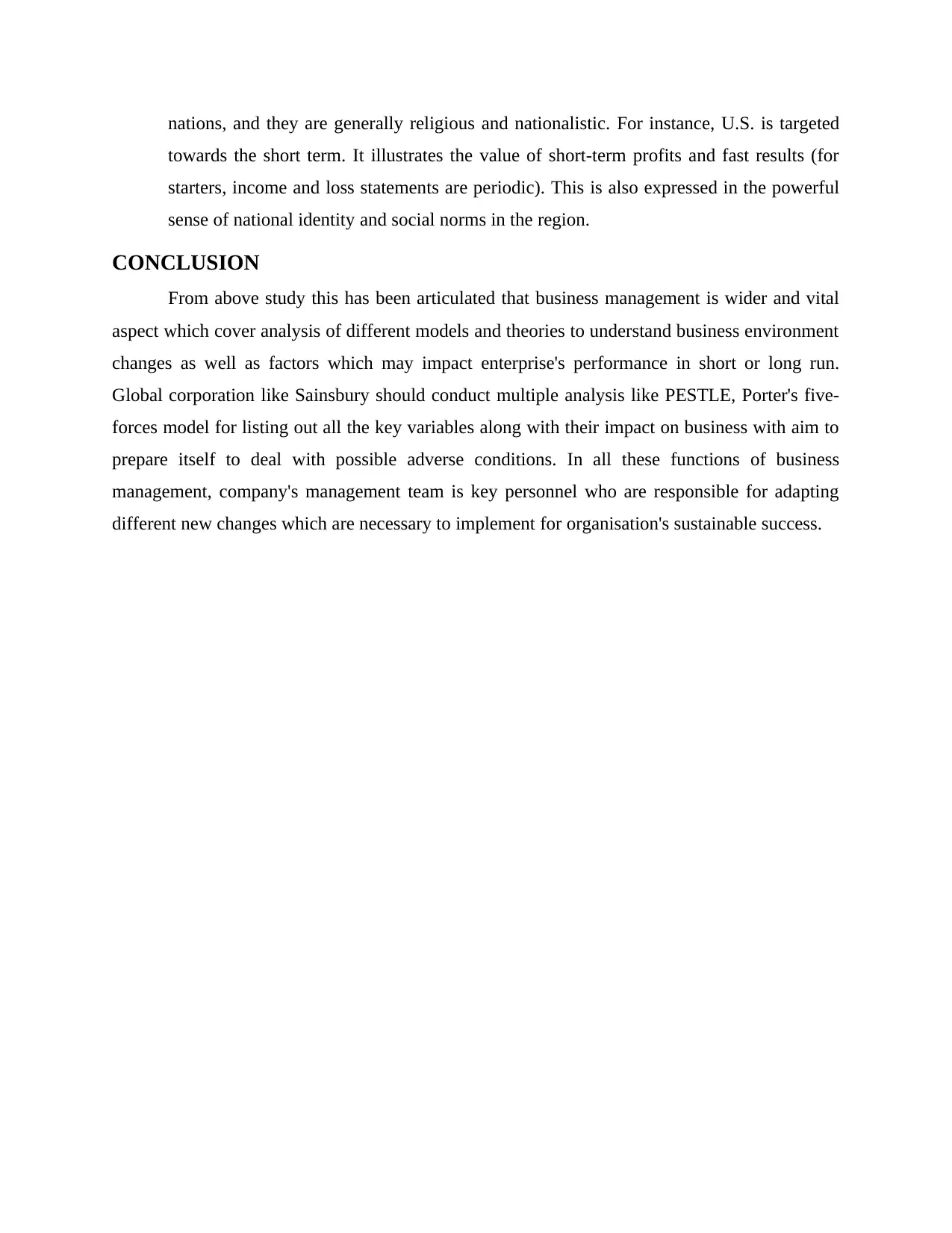
nations, and they are generally religious and nationalistic. For instance, U.S. is targeted
towards the short term. It illustrates the value of short-term profits and fast results (for
starters, income and loss statements are periodic). This is also expressed in the powerful
sense of national identity and social norms in the region.
CONCLUSION
From above study this has been articulated that business management is wider and vital
aspect which cover analysis of different models and theories to understand business environment
changes as well as factors which may impact enterprise's performance in short or long run.
Global corporation like Sainsbury should conduct multiple analysis like PESTLE, Porter's five-
forces model for listing out all the key variables along with their impact on business with aim to
prepare itself to deal with possible adverse conditions. In all these functions of business
management, company's management team is key personnel who are responsible for adapting
different new changes which are necessary to implement for organisation's sustainable success.
towards the short term. It illustrates the value of short-term profits and fast results (for
starters, income and loss statements are periodic). This is also expressed in the powerful
sense of national identity and social norms in the region.
CONCLUSION
From above study this has been articulated that business management is wider and vital
aspect which cover analysis of different models and theories to understand business environment
changes as well as factors which may impact enterprise's performance in short or long run.
Global corporation like Sainsbury should conduct multiple analysis like PESTLE, Porter's five-
forces model for listing out all the key variables along with their impact on business with aim to
prepare itself to deal with possible adverse conditions. In all these functions of business
management, company's management team is key personnel who are responsible for adapting
different new changes which are necessary to implement for organisation's sustainable success.
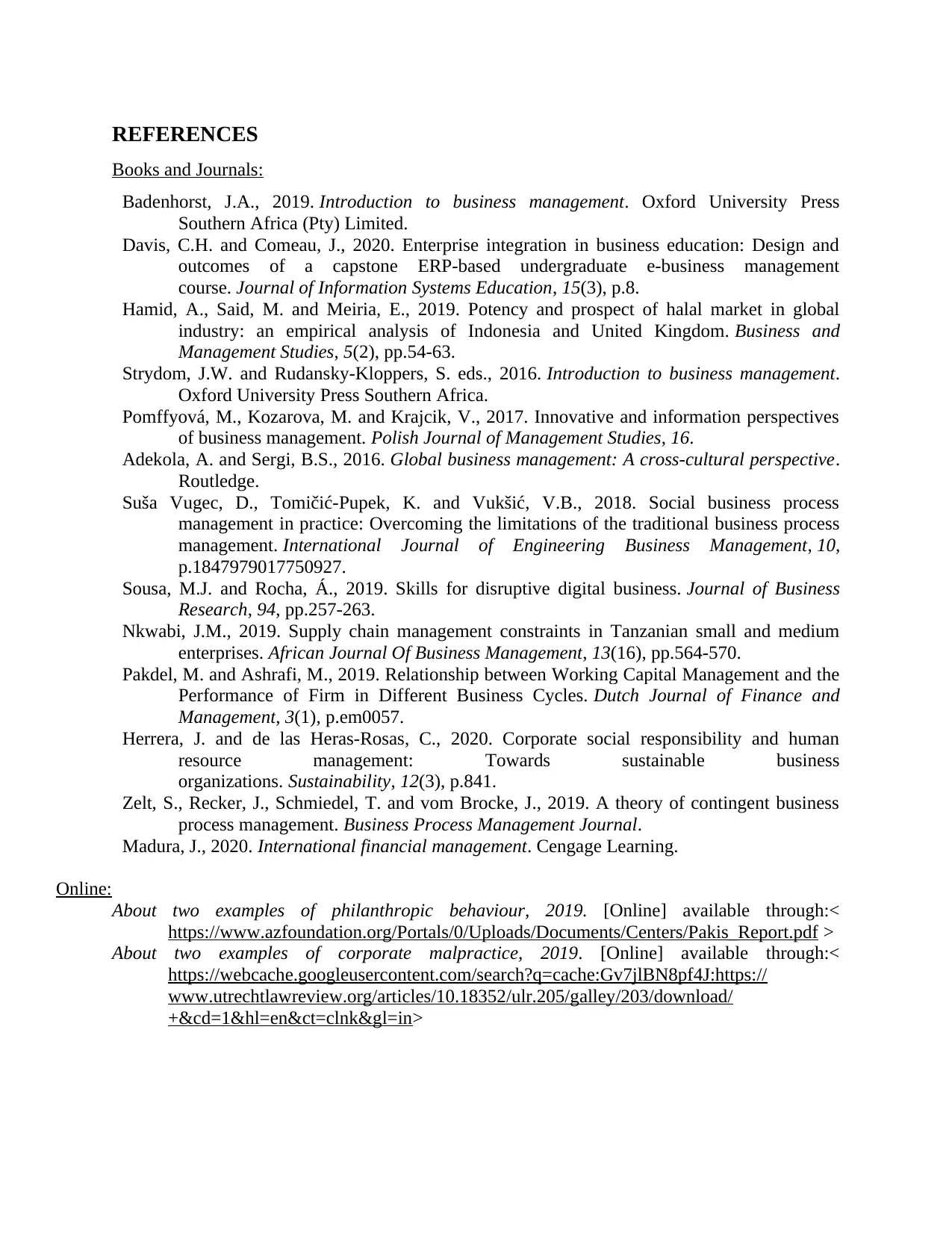
REFERENCES
Books and Journals:
Badenhorst, J.A., 2019. Introduction to business management. Oxford University Press
Southern Africa (Pty) Limited.
Davis, C.H. and Comeau, J., 2020. Enterprise integration in business education: Design and
outcomes of a capstone ERP-based undergraduate e-business management
course. Journal of Information Systems Education, 15(3), p.8.
Hamid, A., Said, M. and Meiria, E., 2019. Potency and prospect of halal market in global
industry: an empirical analysis of Indonesia and United Kingdom. Business and
Management Studies, 5(2), pp.54-63.
Strydom, J.W. and Rudansky-Kloppers, S. eds., 2016. Introduction to business management.
Oxford University Press Southern Africa.
Pomffyová, M., Kozarova, M. and Krajcik, V., 2017. Innovative and information perspectives
of business management. Polish Journal of Management Studies, 16.
Adekola, A. and Sergi, B.S., 2016. Global business management: A cross-cultural perspective.
Routledge.
Suša Vugec, D., Tomičić-Pupek, K. and Vukšić, V.B., 2018. Social business process
management in practice: Overcoming the limitations of the traditional business process
management. International Journal of Engineering Business Management, 10,
p.1847979017750927.
Sousa, M.J. and Rocha, Á., 2019. Skills for disruptive digital business. Journal of Business
Research, 94, pp.257-263.
Nkwabi, J.M., 2019. Supply chain management constraints in Tanzanian small and medium
enterprises. African Journal Of Business Management, 13(16), pp.564-570.
Pakdel, M. and Ashrafi, M., 2019. Relationship between Working Capital Management and the
Performance of Firm in Different Business Cycles. Dutch Journal of Finance and
Management, 3(1), p.em0057.
Herrera, J. and de las Heras-Rosas, C., 2020. Corporate social responsibility and human
resource management: Towards sustainable business
organizations. Sustainability, 12(3), p.841.
Zelt, S., Recker, J., Schmiedel, T. and vom Brocke, J., 2019. A theory of contingent business
process management. Business Process Management Journal.
Madura, J., 2020. International financial management. Cengage Learning.
Online:
About two examples of philanthropic behaviour, 2019. [Online] available through:<
https://www.azfoundation.org/Portals/0/Uploads/Documents/Centers/Pakis_Report.pdf >
About two examples of corporate malpractice, 2019. [Online] available through:<
https://webcache.googleusercontent.com/search?q=cache:Gv7jlBN8pf4J:https://
www.utrechtlawreview.org/articles/10.18352/ulr.205/galley/203/download/
+&cd=1&hl=en&ct=clnk&gl=in>
Books and Journals:
Badenhorst, J.A., 2019. Introduction to business management. Oxford University Press
Southern Africa (Pty) Limited.
Davis, C.H. and Comeau, J., 2020. Enterprise integration in business education: Design and
outcomes of a capstone ERP-based undergraduate e-business management
course. Journal of Information Systems Education, 15(3), p.8.
Hamid, A., Said, M. and Meiria, E., 2019. Potency and prospect of halal market in global
industry: an empirical analysis of Indonesia and United Kingdom. Business and
Management Studies, 5(2), pp.54-63.
Strydom, J.W. and Rudansky-Kloppers, S. eds., 2016. Introduction to business management.
Oxford University Press Southern Africa.
Pomffyová, M., Kozarova, M. and Krajcik, V., 2017. Innovative and information perspectives
of business management. Polish Journal of Management Studies, 16.
Adekola, A. and Sergi, B.S., 2016. Global business management: A cross-cultural perspective.
Routledge.
Suša Vugec, D., Tomičić-Pupek, K. and Vukšić, V.B., 2018. Social business process
management in practice: Overcoming the limitations of the traditional business process
management. International Journal of Engineering Business Management, 10,
p.1847979017750927.
Sousa, M.J. and Rocha, Á., 2019. Skills for disruptive digital business. Journal of Business
Research, 94, pp.257-263.
Nkwabi, J.M., 2019. Supply chain management constraints in Tanzanian small and medium
enterprises. African Journal Of Business Management, 13(16), pp.564-570.
Pakdel, M. and Ashrafi, M., 2019. Relationship between Working Capital Management and the
Performance of Firm in Different Business Cycles. Dutch Journal of Finance and
Management, 3(1), p.em0057.
Herrera, J. and de las Heras-Rosas, C., 2020. Corporate social responsibility and human
resource management: Towards sustainable business
organizations. Sustainability, 12(3), p.841.
Zelt, S., Recker, J., Schmiedel, T. and vom Brocke, J., 2019. A theory of contingent business
process management. Business Process Management Journal.
Madura, J., 2020. International financial management. Cengage Learning.
Online:
About two examples of philanthropic behaviour, 2019. [Online] available through:<
https://www.azfoundation.org/Portals/0/Uploads/Documents/Centers/Pakis_Report.pdf >
About two examples of corporate malpractice, 2019. [Online] available through:<
https://webcache.googleusercontent.com/search?q=cache:Gv7jlBN8pf4J:https://
www.utrechtlawreview.org/articles/10.18352/ulr.205/galley/203/download/
+&cd=1&hl=en&ct=clnk&gl=in>
Paraphrase This Document
Need a fresh take? Get an instant paraphrase of this document with our AI Paraphraser

1 out of 14
Related Documents
Your All-in-One AI-Powered Toolkit for Academic Success.
+13062052269
info@desklib.com
Available 24*7 on WhatsApp / Email
![[object Object]](/_next/static/media/star-bottom.7253800d.svg)
Unlock your academic potential
© 2024 | Zucol Services PVT LTD | All rights reserved.




